 |
Demanding Solutions: A Four-Zone Model of Technological Intervention
Richard Veryard, March 1997
|
Summary
The development and delivery of technological solutions for business
organizations is a key process for all technology suppliers. The concepts
and connections outlined in this paper contribute to a new integrated view
on the dynamic relationship between technology and organizations.
Technology may be regarded as a means to an end, a solution (in some
context) to a requirement. The quality of the solution, of the technology,
can be defined in terms of its ability to satisfy stated or implied needs.
In other words, the match between means and ends.
But there are two sides to this satisfaction. The ability of the technology
to satisfy the needs of the organization crucially depends on the capability
of the organization to accommodate and support the technology. The best
technology will be ineffectual without an adequate process.
This paper describes the relationship between requirements engineering,
quality
management and technology transfer using a third-order model
of requirements engineering and a four-zone model of intervention in organizations.
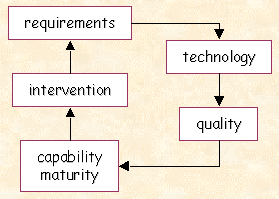
This paper is a brief attempt to sketch the connections between a number
of important themes in our recent work. The structure of the paper is circular.
We start and end with Requirements, exploring in turn Technology, Quality,
Capability (or Process Maturity), and the four-zone structure of Intervention.
Requirements and technology - desire and demand
Technology is often regarded as a means to an end, an instrument or
contrivance, in German: Einrichtung. According to this view, technology
is a series of devices that deliver a series of commodities.
A more sophisticated view of technology concentrates not on the devices
themselves, but on the relationships between devices and commodities. These
relationships are often hidden by an exclusive emphasis on the device,
which Borgmann calls the device paradigm.
The standard path for technological development is to increase the availability
of the technological satisfaction: converting an unreliable or uncontrollable
device into an invisible commodity. Availability means:
-
whenever I want it
-
wherever I want it
-
without difficulty, hassle or risk
The history of television and video can be understood in terms of ever-increasing
levels of availability: 24-hour broadcasting, satellite TV, VCRs and video
rental, and of course Video-on-Demand. The viewer is thus liberated from
the tyranny of a timetable imposed by the TV scheduler, and comes to believe
that he is in control of his own viewing.
Similarly, the history of information and communication technology (ICT)
can also be understood in terms of ever-increasing levels of availability,
with systems becoming more reliable, powerful, user-friendly and portable.
The Internet provides world-wide 24-hour access to a wide variety of information
and commercial services. The user is supposedly liberated from the limitations
of a given hardware or software platform, or the monopoly power of a given
vendor. But paradoxically, this liberation comes from other commitments:
to standard languages and protocols, to given middleware products, or to
advanced methods and tools.
Superstition: Any sufficiently advanced technology is indistinguishable
from magic. Many gurus have scoffed at the 'silver bullet', but then fall
into the trap of providing their own solutions.

Technology and quality
ISO 8402 defines quality as the 'totality of characteristics
of an entity that bear on its ability to satisfy stated or implied needs'.
This definition applies, among other things, to technological entities
such as products and processes. The quality of the solution, therefore,
can be equated with the match between means and ends.
What exactly is a solution? A solution is a deployment of one
or more devices (in some context) to satisfy a requirement. A solution
has some degree of novelty, although it may adopt, adapt and improve
from previous known solutions. Each solution is unique, because each customer
situation is unique.
Which requirements (ends) have technological solution (means)?
Technology can be justified if it enhances the availability of some
business
service. It should improve at least one of the following dimensions:
-
time: more often available, 24 hours, 7 days a week, zero downtime,
faster response, …
-
place: more widely available, distributed, global, new markets,
new types of customer supported, new technical platforms, …
-
ease: reduced skill barriers, quicker to get started, …
-
risk: greater reliability, predictability, security, …
Requirements engineering process
| The requirements engineering process can be regarded as a progression.
It starts with a sense of something lacking (e.g. from an organization
or process or system). It proceeds via a vision or fantasy of
what might compensate for the lack It concludes with an engineerable specification
of
an engineerable product or service. |
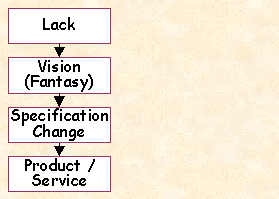
Construction of a solution |
| The management theorist Elliot Jaques traces a similar view back to
Hegel: |
'A goal-directed episode begins with a sense of something
particular which must be done. It may be stimulated from outside by some
thing or occurrence which attracts our attention and which we then choose
to pay attention to - by a chance encounter which must be followed through
or by an invitation to take part in some event, or by an instruction to
carry out an assigned task. Or it may be self-initiated, beginning with
a lack, a felt need, a gap, a sense of something missing, an absence,
and a wish that this gap or lack or absence did not exist. … This sense
of lack next begins to take shape as a desire - the Desire emphasised
and written with a capital D by Hegel. Desire takes the form of wishing
or willing the existence or the completion of something which can
replace the lack or somehow complete or close the episode.' [Elliot Jaques,
The Form of Time (London: Heinemann, 1982) p 112] |
| But although this may be the starting point for requirements engineering,
much of the time is often spent working out what is lacking in the solution.
The specification is itself always incomplete or incoherent or inadequate.
This may be discovered when the product or service is being designed, or
when it is delivered. The diagram shows a simplified view of this iterative
process. |
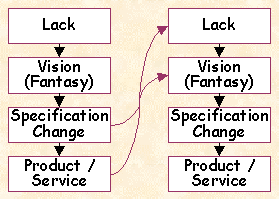
Iterated construction of a solution |
Now let us assume that the specification is a documented statement
of requirements, which can be stored in a computerised design repository,
or embedded in a legally binding contract. Of course, not all requirements
are expressed in this form, but we may use this as a step towards a definition
of what we mean by a requirement.
Current practice in requirements engineering is not well equipped to
ensure the consistency between the vision or fantasy (the perceived solution)
and the actual product or service (the formal solution). Witness the London
Ambulance Service fiasco, where there were conflicting perceptions of the
application: a resource management system or a safety-critical system.
And whence the demand?
| During the requirements formulation process, the requirements owner
is himself transformed: from a 'naive' client who articulates an infinite
(imaginary, fantasy) demand for a magic solution, into a 'mature' client
who articulates a moderated (symbolic, formal) desire for a realistic solution. |
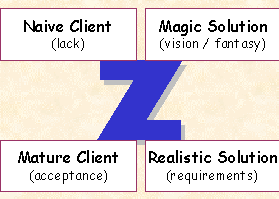
Parallel development of requirements and client |
| The 'maturing' of the client is a function of language. It is the putting
into language of the solution that is important, transforming the vision
into a requirement, and at the same time effecting a transformation in
the client himself. This maturing of the requirements owner is a developmental
process of which the requirements engineer needs to be aware, as it affects
the relationship with the client, and may also well affect the nature of
the contract - at least for the next system, if not for this. Indeed, this
aspect of organisational learning as an outcome of a requirements process
is one that is often unrecognised, but it is part of any engineering discipline
to suggest and incorporate organisational learning improvements in the
processes of that discipline. This transformation can be a highly fulfilling
experience for the participants, as Christopher Alexander reports. |
'Dr. Ryan told us, after his clinic
was built, that this one week he spent with us, shaping the building, was
the most important week he had spent in five years,- the week in which
he had felt most alive.' [Christopher
Alexander et al, The Timeless Way of Building (New York: Oxford University
Press, 1979), p 453] |
Quality and capability
The best technology will be ineffectual without an adequate process.
The ability of the technology to satisfy the needs of the organization
crucially depends on the capability of the organization to accommodate
and support the technology. Technology transfer demands two coordinated
actictivies: assimilation and accommodation.
Assimilation: Changing the technology to fit (literally: make
digestible by) the organization. Assimilation adjusts the function
(purpose, commodity, not to be confused with functionality) and sometimes
the structure of the technology. This can be seen as making the
technological solution more fit-for-purpose.
Accommodation: Changing the organization and its processes to
fit (literally: make room for) the technology. Accommodation adjusts the
structure
(and sometimes the function) of the organization. This can be seen
as making the organization more capable. Capability is frequently
measured in terms of maturity.
Capability and intervention
Intervention to enhance capability demands activity across four zones.
Each zone is characterized by a different discourse, a specific
process of argument (or dialectic) having a particular perspective and
goal.
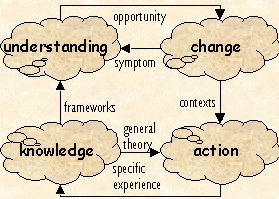
Some of the interactions between discourses
Negative discourses
In the previous section, the four discourses were described in positive
terms. Understanding, action, change and knowledge - these are all Good
Things. We should remember that each of these discourses contains its opposite:
-
The Discourse of Misunderstanding
-
The Discourse of Inaction and Excuses
-
The Discourse of Resistance and Inertia
-
The Discourse of Not-Learning and Ignorance
In many organizations, these negative forms of the discourses will be more
familar than the positive forms.
We are implying an ethic in which the positive discourses are better
than the negative ones: thus understanding is better than misunderstanding,
and so on. We are also implying an epistemology in which the positive discourses
can be distinguished objectively from the negative ones: thus change is
objectively different to inertia. Who would question these two implications?
Zonal Issues
Various issues gravitate towards particular zones. To put it another
way, each discourse makes visible (or audible) certain issues, allowing
them to be problematized:
-
Change ecological issues: problem, stakeholder, benefit, cost, risk,
…
-
Knowledge epistemological issues: progress, paradigm, commodity
fetish, ownership, …
-
Action ethical issues: authority, responsibility, agency, …
-
Understanding practical issues: perspective, purpose, reflexivity,
…

Medical intervention
For a very simple illustration of the four-zone intervention model,
we can consider a medical intervention.
We said above that descriptions of the four-discourse structure tend
to privilege one of the four discourses. This diagram, for example, privileges
the KNOWLEDGE discourse, showing it on a different logical level to the
other three.
Although this is shown as a simple sequential loop, this is only true
for the simplest cases, if then. The doctor contract (which may include
the selection of practitioner, as well as the negotiation between practitioner
and client) is always subject to review. Medical actions may be designed
to increase the practitioner's knowledge of the patient - thus a surgical
operation may be diagnostic in intention yet therapeutic in effect, or
vice versa. The zones overlap/iterate, and the activities within each zone
overlap/iterate.
Note: This model seems to apply just as much to so-called holistic medicine
as to orthodox medicine. In the one case, the sufferer has to make a choice
of alternative practitioners (acupuncture versus homeopathy versus aromatherapy);
in the other case, the sufferer's representative (the GP) may have to procure
treatment through a so-called internal market.

Four zone model applied to medical intervention
Authority and knowledge
One of the issues raised by this view of medical intervention is the
relationship between authority and knowledge.
How much authority does the doctor need to take (for medical effectiveness)?
How much authority does the doctor want to take (for the doctor's psychological
comfort)?
How much authority does the patient need/want/expect to give the doctor?
How much authority does the doctor inherit from the prevailing social institutions
(including NHS bureaucracy, but also the socio-economic system as manifested
through education levels and accent)?
How does the doctor's authority relate to his access to medical and pharmaceutical
knowledge? How does the doctor refresh his/her knowledge? How does the
medical community refresh its knowledge?
To which medical authorities does the doctor defer? How influential are
the drug companies? How influential are the medical research trusts? How
visible are these influences?
These questions are relevant to the doctor contract, but extend beyond
this.
Intervention and requirements
Now let us examine the four-zone model as it applies to technology
transfer. The sequence starts with a lack, or rather a perception of lack.
This is easy to see in the case of demand-pull, but is not so easy to see
in the case of technology-push. Our model is based on the assertion that
the most glib technology sales person will fail to sell a product unless
it echoes, at least subjectively, with something in the customer organization.
The fact that the customer is prepared to sign a purchase order is evidence
that the customer lacks something, although it of course doesn't
follow that there is any match between this lack and the product he has
bought.
Both assimilation (the adaptation of the solution to the organization)
and accommodation (the adaptation of the organization to the solution)
presuppose some understanding (or misunderstanding) of both. We may suppose
that understanding is better than misunderstanding, since we can often
detect the consequences of each.
Authority in organizational interventions
In the medical intervention example above, we discussed the question
of the authority of the doctor, and its relationship to knowledge. The
same question applies to organizational intervention.
If we identify an organizational agent of change, be it a consultant,
systems analyst or requirements engineer. What (or who) gives this agent
his/her authority? What is the source of this agent's knowledge? These
issues are usually overlooked by requirements engineering or systems analysis
methods.
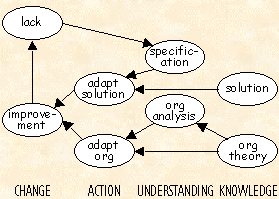
Four zone model applied to technology transfer
Roles and responsibilities
Very crudely speaking, the model allows us to see four different roles
and their responsibilities:
Desired and actual change is located in the user organization
The requirements engineer facilitates an understanding of the problem
and what would count as a solution
Reusable knowledge is located with the technology supplier and his
products
Action to adapt the technology solution to the user organization,
and vice versa, may be coordinated by
an implementation manager (working for the user), and/or
a delivery manager (working for the technology supplier), and/or
an independent 'consultant'
Note that the model only depicts the process of implementation or delivery
of a solution to satisfy a user demand. The arrows mostly go from right
to left, from the suppliers to the users. This omits both the short-term
feedback loops and the longer term marketing (requirements gathering) processes
that guide the further development of technological products.
Supplier demands
The model presented in this paper is assymetrical, with the user organization
playing the role of the one-who-demands, and the technology supplier playing
the role of the one-who-satisfies. Clearly, however, there is a sense in
which the technology supplier also has demands which the user organization
must satisfy.
sufficient financial reward to cover the costs and risks (including future
development)
additional 'sales capital', in terms of success stories and reference sites,
as well as an improvement in the relationship with this customer, facilitating
future sales
additional 'knowledge capital' to support future product development, marketing
and sales
and, above all, a stream of interesting problems and opportunities.
Some large technology users have well-worked-out procurement policies which
allow for deliberate intervention in the product R&D strategies of
their key suppliers. This form of intervention can also be represented
in a four-zone model.
References
This document is partially based on a paper for CEEDA 96,
the 3rd International Conference on Concurrent Engineering & EDA, 18th-19th
January 1996, Poole, UK. It also draws on the following papers:
-
R.A. Veryard, 'IT Implementation or Delivery: Thoughts on
Assimilation, Accommodation and Delivery' in Proceedings of IFIP WG
8.6 Working Conference on the Diffusion and Adoption of Information Technology,
(Oslo, October 1995)
-
R.A. Veryard & J.E. Dobson, 'Third Order Requirements
Engineering: Vision and Identity', in Proceedings of REFSQ 95, Second
International Workshop on Requirements Engineering, (Jyvaskyla, Finland:June
12-13, 1995)

| top
home page
contact us |
 |
| |
Content revised on March 6th, 1997.
Technical edit: February 22nd, 2002
Copyright © 1996, 1997 Veryard Projects Ltd
http://www.veryard.com/tcm/ds4ztt.htm
|









